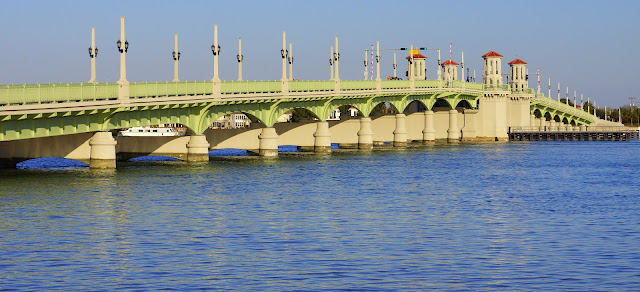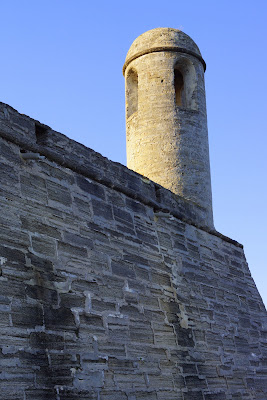A day walking through the city of St. Augustine revealed many dimensions of its long history. Its Spanish roots (from 1565) are evident everywhere, in original structures and in the repetition of architectural themes in more modern buildings. The city has done an exceptional job of preserving its historical features, and continues to capitalize on them.
St Augustine is very different from Charleston. It never became a thriving shipping port like Charleston, and it has no extensive neighborhoods of substantial old homes where the wealthy shipping magnates and plantation owners lived. St. Augustine became a resort city eventually, and so has a few really big historical hotels and lots of more modest homes. I guess all those folks who worked in the resorts had to live somewhere. I have no idea what kind of agriculture there might have been around here - all the literature focuses on it's military history.
The old city gates stand at one end of several historically reconstructed streets running parallel to the harbor, that are now the shopping, dining and lodging center for tourists.
It's hard to tell how much of the old buildings are original and how much are new construction, which I guess speaks to how well they are reproduced. Because of the commercial nature of their current use, it feels almost Disneyish at times. We didn't think the shops were all that interesting in general, (lots of fudge, T-shirts and places to buy comfortable shoes and belly-dancing outfits!) but then we were more into taking pictures than shopping.
Many of the old buildings have these heavy second story porches overlooking the street. It all looks very European. And of course you can take a carriage ride around town if you want.
On the side streets you can find tiny homes that look pretty darn old. Many are lighted for their winter "Nights of Lights" festival.
After we walked the length of the old town streets we came out in an area that is dominated by the massive old Hotels Alcazar and Ponce de Leon, and the new Casa Monica Hotel. Flagler College has moved into the Ponce de Leon and maintained its historic magnificence, and the Lightner Museum has done the same for the Alcazar.
The stone and iron fence around Flagler/Ponce de Leon suggests the military history of the city, with these spiked ball and chain links.
I think it was brilliant of Flagler College to put this grand old resort to use as part of their campus. I've recently heard of other colleges taking over empty downtown buildings in other cities for extensions of their campus. What a great idea.
This is a view of the modern Casa Monica Hotel on the left and the Lightner Museum on the right.
One of the Lightner Museum's towers:
The lobby of the Lightner is open to the public without paying the admission. The Museum and its lobby house a collection of historical musical instruments, furniture, sculpture and other art.
We chose not to do the Museum in full, and so turned toward the water and strolled by the beautiful Lion Bridge that passes over to St. Augustine Beach.
The walkway along the water took us by many large sailboats anchored in the harbor, as well as one working shrimp boat. Here you can see the Castillo de San Marco in the distance. It is now a National Monument, so our Senior Pass got us in for free. : )
The Castillo is a Fort built by the Spanish in the late 1600's to defend the settlement, primarily from the British at the time. From the top, the moat below seems to be star shaped, but its really a square with extra points at each corner.
The history of this fort is well described on the Wikipedia link above, but one interesting fact is that it changed hands six times: Spanish, British, Confederacy and the US (twice by the Spanish and the British). Below is one of the sentry boxes that stands at each of the four corners.
Battlements from which guns and cannons were fired:
In order to deliver maximal damage to ships in the harbor, the iron cannon balls were heated in an oven before they were loaded into the cannon. Below is the "mouth" of the "hot shot" oven into which the cannon balls were fed, rolling down the ramp, through the hot oven and out the other side. I can't imagine how they then got them from their into the cannon.
Some of the cannon were very fancy Spanish brass things with lots of decoration.
Others were your basic black.
Here's Rick standing in one of the sentry boxes. Doesn't he look happy and right at home?
We had dinner in the old city after leaving the Castillo. There are so many restaurants to chose from in the area, and with no really good guidance, we just picked one: The Cracker Cafe. ("Cracker" is what poor backwoods Floridians were/are called - those who eat gators, possums, roadkill and such.) Dinner was OK - we didn't sample any traditional cracker fare.
Tomorrow we leave St. Augustine and head for The Great Outdoors in Titusville, where we'll be for a month.



















No comments:
Post a Comment
Want to leave a comment?